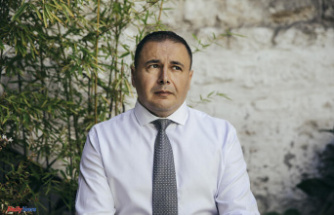The laundry is hanging. Despite the stiff northerly breeze. It may all look a bit provisional, but with the generous painterly commitment and completely devoted to the everyday life of the little people, one really likes one's Liebermann. The oil study is hardly suitable for representation. But the West Coast Art Museum on the North Sea island of Foehr is proud of its possessions, their work by the famous Impressionist, who was born 175 years ago.
And it is primarily proud of the fact that exemplary research has succeeded in clearing up all previous owner doubts. There were claims for restitution that proved to be unfounded in a meticulous and fair reconstruction of the history of the picture. Which is now also recognized by the parties involved. Above all, the thoroughly plausible suspicion that the picture, which belonged to the Leipzig entrepreneur Moritz Ury, who emigrated to Switzerland in 1937, could have been illegally confiscated from him, fueled the doubts that the provenance researchers have been dealing with since 2017.
One does not need to go into detail about the art-historical and legal moves in order to get the impression of a highly accurate investigation. For example, the back of the picture was examined in meticulous detail, there is a label with the red number "133" next to a stamp from the Berlin customs office at Anhalter Bahnhof, numbers and names are stuck on everywhere and written down by hand.
Every hint, no matter how hidden, has been followed, step by step the history of ownership has been reconstructed. In 1926, the painting made stops at the Goldschmidt art dealership in Frankfurt and at the Cassirer gallery in Berlin, which sold it to Moritz and Selma Ury in 1931 for 3,000 Reichsmarks. It remained in the family possession (from 1945 in San Francisco) until it was sold to a Hanover gallery in 1981.
Nine years later, the Liebermann painting turned up at an art fair in Düsseldorf, where it was eventually acquired by Hans-Georg Karg, owner of the Hertie concern. After his death, the picture was to be auctioned off in favor of the Karg Foundation. But it was withdrawn because Maria Ury, Moritz Ury's daughter-in-law, raised claims for restitution.
The lawyers of the foundation on the one hand and the Ury family on the other hand took over. Both parties committed themselves to an "open book policy", which means the complete disclosure of all known information that could help to clarify the origin story. And finally, the picture with the laundry maid was solemnly acquitted:
"Judging by the chain of evidence, the work must have been in the Ury family's possession from 1926 until the early 1980s," the booklet says, which documents the provenance research very clearly, "and will then have entered the German art trade from there be.” There was no sale directly related to the emigration. The Ury descendants parted with the inherited painting “for personal reasons and at a reasonable price”.
The scholarly effort in this case concerns an artist who is repeatedly the subject of complicated image rights cases. This is not least due to the fact that Max Liebermann, himself a Jew, was perhaps the most German painter of the first half of the 20th century. The elegant lightness of his painting, the motivic charm of his pictures, the simple world he describes - all of this brought him an enormous audience.
Unlike in the French subject, Liebermann did not require a basic course in the history of the development of modernity. Monet's curious view of urban bourgeoisie, Pissarro's dreamy distance from the city, Corot's Arcadian gentleness, Renoir's defiant insistence on the myth of the nymph - Liebermann's market-oriented strategies are far removed from these. Nor did he wrestle with a Montagne Sainte-Victoire like Cézanne did.
In fact, he never wrestled. Because he was able to paint everything, sunny days in the beer garden, bathing days at the sea, goose plucking women and vegetable cleaning women, privy councilors and general directors, twelve-year-old Jesus teaching adults, Tobias, who was hardly older, accompanied by angels, the granddaughter with the nanny. And if he's watching tennis players change shots today, he'll be enjoying people in the park again tomorrow.
And always the same brilliant technique, which he never uses in any other way than sovereignly and always to the delight of his many admirers. Liebermann still has the finest means for the tenderest ray of sunshine. One stands behind the girls whom he lets walk in the summer forest and one thinks the view couldn't be happier. This is a truly immortal picture, over which one forgets all artistic efforts and sinks wonderfully helplessly into one's own summer forest memories and feelings. Up until the 1930s, Liebermann was a “must” for cultivated taste. Also and especially in Jewish collections. At least until 1933.
Then the civil understanding broke abruptly. The collections were liquidated, forcibly sold, and Liebermann was demoted to being the currency earner of National Socialist cultural policy. If you read Liebermann's letters from his last days, the shock of this sudden contempt becomes omnipresent. From 1933 onwards, many Liebermann objects were forced to change their location and their owners: They were stolen from persecuted families, taken into exile, sold under the most difficult circumstances in financial distress or sold by German museums. The Liebermann family also lost most of their art collection during the National Socialist era.
And the bad legacy has not been completely removed to this day. Even in the Liebermann Villa in Wannsee in Berlin, the origin of the collection, which includes more than 200 objects, has not been fully clarified. A large exhibition with the latest provenance results has been announced for the autumn.
"Provenance stories. Max Liebermann in Focus”, until March 19, 2023, Museum of Art of the West Coast, Alkersum/Föhr; "When Pictures Speak", October 1, 2022 to March 13, 2023, Liebermann-Villa, Berlin












